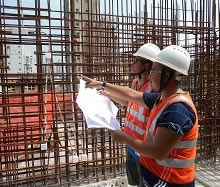
Contractors and service providers are required to engage in a number of initiatives to enhance safety management. Management commitment is a key driver for ensuring site safety. Going extra mile plus providing a safe system of work and adopting safe practices are crucial in achieving the target of safety management.
|
Incorporation of a safety pledge
|
|---|
|
We incorporate a safety pledge in our business guide which requires a pledge from contractors to maintain the highest site safety standards, strive for continuous improvements and commit to promote a safety culture. Implementation of quarterly HASAS independent safety audits
Contractors' safety management systems are the foundation towards ensuring work safety. For new works contracts, the site safety management systems and the effectiveness of their implementation are, therefore, audited quarterly under the Housing Authority Safety Audit System (HASAS). Implemented in 1996, HASAS continues to provide a professional and independent system to assess safety performance of contractors. To cater for the unique nature of maintenance and improvement activities, a tailor-made safety audit system to District Term Contracts will also be developed. Implementation of SSIP Surprise Safety Inspection Programme
On top of the HASAS independent safety audits, Surprise Safety Inspection Programme (SSIP) was implemented in Housing Authority New Works Contracts in 2013. The SSIP aims to raise vigilance and further enhance safety management on site through surprise site visits by independent safety inspectors. It focuses on high-risk activities and compliance checks on physical conditions on site based on objective checklist with a marking scheme. Adoption of integrated ‘Pay for Safety, Environment and Hygiene’ Scheme
To remove site safety considerations from the realm of competitive tendering, the Pay for Safety Scheme (PFSS) was first introduced to new works building contracts in 2000. It was subsequently enhanced in 2003 to form an integrated payment scheme applicable to all new works contracts—covering site safety, environmental management and site hygiene items (the integrated PSE&H Scheme). The introduction of the PFSS has paved the way for a cultural change through the introduction of positive incentives—whereby contractors are paid only if they have satisfactorily performed their obligations. Failure to perform site safety obligations will result in no, or reduced payment. To provide further incentives for contractors to fulfil their obligations, the following enhancements, with more performance-driven emphasis, have been incorporated into the PFSS under new works contracts:
In respect of maintenance works, PFSS was first introduced to cover building works maintenance contracts in 2003 and its scope was enhanced in 2007 to additionally cover building services works maintenance contracts. Implementation of the Safe Working Cycle
Adopting the Safe Working Cycle allows integration of safety practices with daily routine works. This etho spans all levels of site personnel and assists in the implementation of effective safety management systems. Restricting tiers of subletting for high-risk operations
The restriction of subletting for high-risk operations is aimed at eliminating non-value added subletting, while still maintaining business vitality within the industry. Voluntary Direct Notification of Hazardous Repair, Maintenance, Alteration and Addition (RMAA) Works to Labour Department
Due to the small scale and short duration of RMAA works in general, they are exempted from the notification requirement under CSSR. However, this may leave a gap for other RMAA works which involve hazardous operations, leading to difficulties in enforcement by the Labour Department. For hazardous RMAA works of the public housing estates, a voluntary mechanism of direct-notification to the Labour Department was established in 2008. The mechanism helps to curb unsafe practice and fosters compliance with safety provisions by giving early advice or warnings to contractors and workers through inspections and/or enforcement actions. Under the mechanism, five specific categories of RMAA works involving special hazards, and two special circumstances were included in the voluntary/direct notification mechanism: RMAA works for direct notification to Labour Department
Special circumstances for direct notification to Labour Department
|
